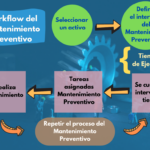
What is Preventive Maintenance?
⚙️ What is Preventive Maintenance? ⚙️
Preventive maintenance is an essential aspect of any maintenance strategy. It refers to the regular and proactive inspection, cleaning, lubrication, and repair of equipment to prevent breakdowns and ensure optimal performance. By performing scheduled maintenance tasks, organizations can minimize downtime, extend the lifespan of their assets, and reduce overall repair costs.
One of the primary benefits of preventive maintenance is the ability to identify and address potential issues before they escalate into critical problems. By conducting regular inspections and servicing, technicians can detect and fix small faults or wear and tear that might otherwise go unnoticed. This proactive approach helps to prevent unexpected breakdowns, improve efficiency, and maintain the reliability of equipment.
Implementing a preventive maintenance program involves creating a detailed schedule that outlines the specific tasks and intervals for each piece of equipment. This plan should consider factors such as manufacturer recommendations, historical data, and operational requirements. By adhering to this schedule, organizations can ensure that maintenance activities are performed consistently and systematically.
In summary, preventive maintenance is crucial for maintaining the optimal functionality and longevity of equipment. By implementing a proactive approach, organizations can prevent costly breakdowns, extend the lifespan of their assets, and improve efficiency. Don’t wait for equipment failure to occur; take the initiative to schedule regular inspections and servicing to keep your operations running smoothly.
The Importance of Preventive Maintenance
😊
Preventive maintenance is a vital aspect of any successful business. It involves regularly inspecting, servicing, and replacing equipment to prevent breakdowns and extend its lifespan. By implementing a proactive maintenance strategy, companies can save money, reduce downtime, and ensure the smooth operation of their facilities.
One of the key benefits of preventive maintenance is the avoidance of unexpected equipment failures. When machinery breaks down unexpectedly, it can be costly to repair and can disrupt the workflow. By taking preventive measures, such as lubricating moving parts and replacing worn-out components, companies can minimize the risk of sudden breakdowns.
Regular maintenance also helps identify and address potential issues before they become major problems. Through inspections and routine servicing, technicians can detect early signs of wear or malfunctions, allowing them to make repairs promptly. This proactive approach prevents small issues from escalating into larger, more complicated ones that could result in costly repairs or even equipment replacement.
Furthermore, preventive maintenance improves workplace safety. In industries where heavy machinery is involved, regular checks and maintenance ensure that equipment is working correctly and does not pose a danger to employees. By minimizing the risks of accidents or injuries, companies can create a safer work environment.
Another advantage of preventive maintenance is increased energy efficiency. Well-maintained machinery operates more efficiently, using less energy and reducing utility costs. By regularly cleaning and tuning equipment, companies can optimize its performance and extend its lifespan while simultaneously saving on energy expenses.
Lastly, preventive maintenance helps companies maintain a positive reputation. When machinery is well-maintained, companies can consistently deliver high-quality products or services on time. This reliability and efficiency not only impress customers but also foster trust and loyalty, leading to repeat business and positive word-of-mouth recommendations.
- 🔧🌬️¡Mantén tu aire acondicionado y refrigeración en óptimas condiciones! Guía de mantenimiento 🌡️❄️
- 🚗🔧 Guía completa de mantenimiento de vehículos PDF: Cómo cuidar tu coche a través de un manual en formato digital
- 🔢🔥 Fórmula para calcular las 🍽️⚙️calorías de mantenimiento: ¡Aprende a calcular las energías necesarias para mantener tu peso ideal!
- 🔧 Explora las mejores actividades de mantenimiento preventivo de computadoras para mantener tu PC en óptimas condiciones
- 💡 «🛠️ Bajo Mantenimiento: Descubre cómo ahorrar tiempo y esfuerzo en tus tareas diarias
Benefits of Implementing Preventive Maintenance
🔧
Implementing preventive maintenance in any industry or business can bring a multitude of benefits and can significantly improve overall operations. From reducing downtime to increasing equipment lifespan, here are some of the advantages that come with a well-planned preventive maintenance program:
1. 📉 Minimized downtime: By regularly maintaining equipment and addressing issues before they become major problems, preventive maintenance helps to minimize unexpected breakdowns and subsequent downtime. This results in increased productivity and reduced costs associated with repairs and unplanned downtime.
2. 💰 Cost savings: Implementing preventive maintenance can lead to significant cost savings in the long run. By addressing minor issues at early stages, businesses can avoid expensive repairs and replacements later on. Additionally, preventive maintenance helps to extend the lifespan of equipment, ultimately saving money on purchasing new machinery.
3. 🔄 Improved equipment performance: Regular maintenance ensures that equipment is running optimally. By regularly replacing worn-out parts, cleaning and lubricating machinery, and performing necessary calibrations, preventive maintenance can improve equipment performance, resulting in better quality outputs and increased customer satisfaction.
4. 📊 Increased operational efficiency: Preventive maintenance programs help businesses adopt a proactive approach to equipment management. By scheduling maintenance activities and regularly monitoring key equipment metrics, organizations can optimize operations and ensure smooth workflow, leading to increased efficiency across the board.
5. 🌍 Enhancing workplace safety: Regular maintenance not only helps to identify and address potential equipment failures, but it also contributes to creating a safer work environment. By regularly inspecting and maintaining machinery, businesses can reduce the risk of accidents, injuries, and potential legal liabilities.
6. ⏰ Extending equipment lifespan: Preventive maintenance goes beyond addressing immediate issues. It includes activities such as cleaning, lubricating, and adjusting equipment to prevent wear and tear. By implementing such maintenance practices, organizations can extend the lifespan of their equipment, reducing the need for frequent replacements and saving resources.
In conclusion, implementing preventive maintenance brings a wide range of benefits, including minimized downtime, cost savings, improved equipment performance, increased operational efficiency, enhanced workplace safety, and extended equipment lifespan. By adopting a proactive approach to equipment management, businesses can optimize their operations and maximize productivity in the long run.
Best Practices for Preventive Maintenance
🔧 Best Practices for Preventive Maintenance 🔧
Preventive maintenance plays a crucial role in ensuring the efficiency and longevity of any system or equipment. By taking proactive measures, you can minimize the risk of unexpected breakdowns, reduce downtime, and save costly repairs. In this article, we will discuss the best practices for preventive maintenance that can help you optimize the performance of your assets.
1️⃣ Regular Inspections: Conducting regular inspections is essential to identify potential issues before they escalate into major problems. These inspections should include visual checks, lubrication, and testing of critical components. By spotting early signs of wear and tear, you can address them promptly, preventing costly breakdowns.
2️⃣ Implementing a Maintenance Schedule: Developing a comprehensive maintenance schedule is crucial for effective preventive maintenance. This schedule should outline specific tasks to be performed at regular intervals, such as equipment cleaning, filter replacements, and calibration. Adhering to the schedule ensures that maintenance activities are carried out systematically, preventing any negligence or oversight.
3️⃣ Keeping Accurate Records: Documentation plays a crucial role in preventive maintenance. Keeping detailed records of maintenance tasks performed, parts replaced, and repairs made provides valuable insights and trend analysis. Accurate records help in identifying recurring issues, predicting future maintenance requirements, and optimizing resource allocation.
4️⃣ Training and Empowering Staff: Effective preventive maintenance relies on skilled and knowledgeable staff. Providing comprehensive training on maintenance procedures, safety protocols, and equipment operation is crucial. Empowering staff to report potential issues and encouraging a culture of proactive maintenance can go a long way in preventing costly breakdowns and improving overall maintenance effectiveness.
By implementing these best practices for preventive maintenance, you can ensure the efficient functioning of your equipment and systems while minimizing unexpected downtime and costly repairs. Remember, proactive measures and attention to detail can save you significant time, money, and stress in the long run. Stay tuned for more valuable insights on maintenance techniques and strategies!
Conclusion: Making Preventive Maintenance a Priority
🔧
Making preventive maintenance a priority is crucial for maintaining the longevity and efficiency of any system or equipment. By regularly inspecting, cleaning, and repairing components before they fail, businesses can avoid costly breakdowns and disruptions in their operations.
One of the key benefits of prioritizing preventive maintenance is the ability to identify potential issues before they turn into major problems. By conducting regular inspections and routine check-ups, businesses can detect early signs of wear and tear, allowing them to take proactive measures to prevent equipment failure.
In addition to avoiding unexpected breakdowns, preventive maintenance also helps businesses save money in the long run. By investing in regular maintenance and repairs, companies can extend the lifespan of their equipment, reducing the need for expensive replacements.
Furthermore, making preventive maintenance a priority can significantly improve the safety of both employees and customers. By ensuring that equipment is in optimal condition, businesses can minimize the risk of accidents and injuries caused by faulty machinery.
Implementing a preventive maintenance program also allows businesses to streamline their operations by reducing downtime. Ensuring that all equipment is in good working order reduces the likelihood of disruptions and allows for smoother, uninterrupted processes.
In conclusion, making preventive maintenance a priority is an essential aspect of any business’s operations. By regularly inspecting and maintaining their equipment, businesses can avoid unexpected breakdowns, reduce costs, improve safety, and streamline their operations. Prioritizing preventive maintenance is a proactive approach that ultimately leads to increased efficiency and success in the long run.
 🔧♀️ Descubre todo sobre el Mantenimiento Preventivo del Torno: ¡Tips y consejos para su correcto cuidado!
🔧♀️ Descubre todo sobre el Mantenimiento Preventivo del Torno: ¡Tips y consejos para su correcto cuidado! 🧠💡Descubre cómo el mantenimiento preventivo mapa mental puede optimizar tus procesos
🧠💡Descubre cómo el mantenimiento preventivo mapa mental puede optimizar tus procesos 🔍💡 Descubre las ventajas y desventajas del mantenimiento proactivo: ¿Qué debes saber?
🔍💡 Descubre las ventajas y desventajas del mantenimiento proactivo: ¿Qué debes saber? 📘 Descubre cómo realizar el 🧰 mantenimiento preventivo libro para prolongar su vida útil
📘 Descubre cómo realizar el 🧰 mantenimiento preventivo libro para prolongar su vida útil 🔧💡 Descubre la importancia del mantenimiento preventivo técnico: guía completa para optimizar tus equipos
🔧💡 Descubre la importancia del mantenimiento preventivo técnico: guía completa para optimizar tus equipos 🛠️ ¿Qué entiendes por Mantenimiento Preventivo? Aprende la importancia de cuidar tus equipos con anticipación
🛠️ ¿Qué entiendes por Mantenimiento Preventivo? Aprende la importancia de cuidar tus equipos con anticipación 🚗💡 Guía completa de Mantenimiento Preventivo Vehicular: Consejos y Tips para un Auto en Óptimas Condiciones
🚗💡 Guía completa de Mantenimiento Preventivo Vehicular: Consejos y Tips para un Auto en Óptimas Condiciones 🔧💡 El secreto del éxito: 🔎 Mantenimiento preventivo ¿Para qué sirve? Descubre todos sus beneficios y cómo aplicarlo en tu vida diaria
🔧💡 El secreto del éxito: 🔎 Mantenimiento preventivo ¿Para qué sirve? Descubre todos sus beneficios y cómo aplicarlo en tu vida diaria 🔧 ¡Aprende cómo realizar el 🔎 Mantenimiento Preventivo Manual! Guía completa paso a paso 📚
🔧 ¡Aprende cómo realizar el 🔎 Mantenimiento Preventivo Manual! Guía completa paso a paso 📚